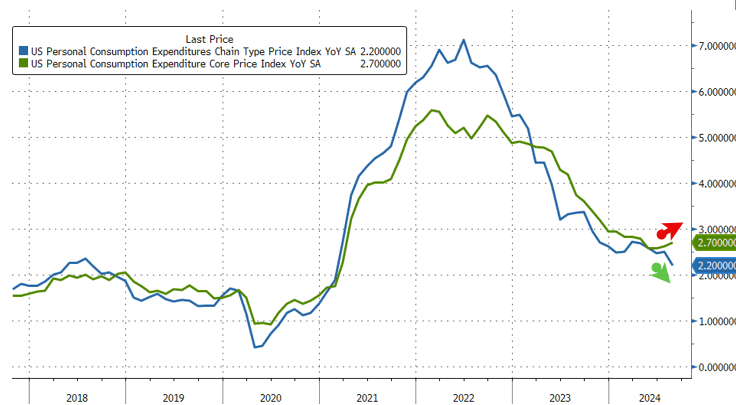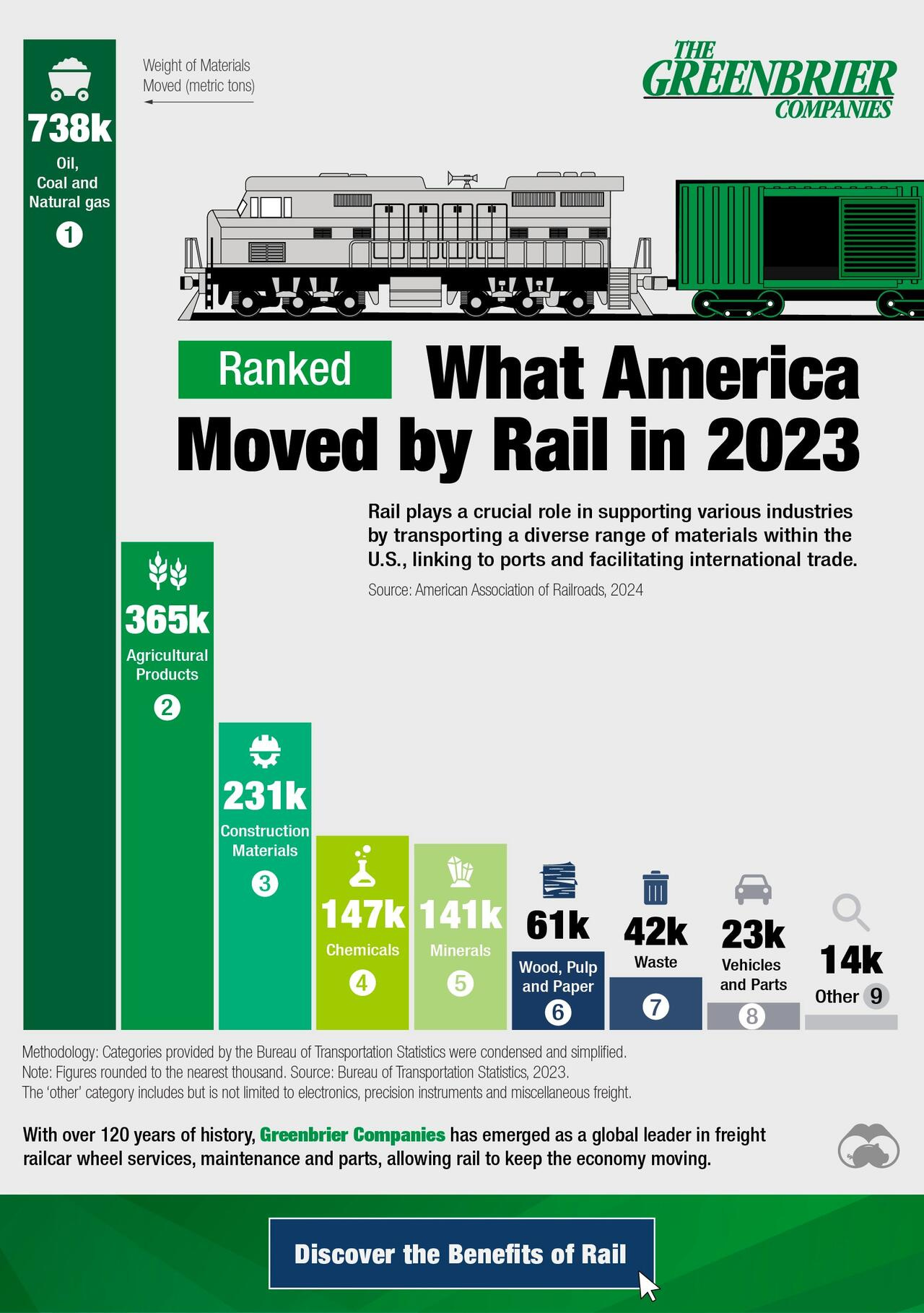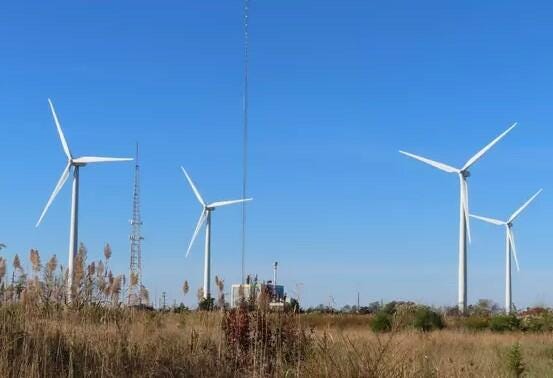Weekly Skepticism #9
After taking a week off, it's back to the grind...Latest data from the fed and more stims..Rail Roads carry more than you think..The U.K. turning into Germany (dumb energy policy)...Climate change!!
Fed’s Inflation Indicator Hits Highest Level Since April as Handouts Soar
The latest data on the Fed’s favored inflation metric—Core PCE—reveals a mixed bag. Month-over-month, it nudged up just 0.1%, underperforming expectations of 0.2%. However, on a year-over-year basis, it climbed from 2.6% to 2.7%, marking the highest point since April.
Meanwhile, headline PCE dipped to 2.2% year-over-year, its lowest since March 2021.
A concerning trend emerges with the so-called SuperCore PCE, which re-accelerated in August to a striking 3.29% YoY.
Income and spending figures came in weaker than anticipated, with income posting its smallest monthly gain since July 2023 and spending hitting its joint-lowest point since January 2024. On a year-over-year basis, growth for both metrics is decelerating.
Revisions have thrown the savings rate into disarray; currently at 4.8% of disposable income, it’s the lowest since December 2023, a stark contrast to the pre-revision July figure of 2.9%. The dramatic upward revision to personal income might create a misleading picture, with spending also adjusted higher but to a lesser extent.
It’s evident that the government’s substantial handouts are propping up consumer finances. Without this influx of cash, the consumer would be in dire straits, yet key inflation indicators stubbornly remain elevated. Expect the Fed to continue its path of cuts—especially in an election year—setting the stage for a potential return of hyperinflation reminiscent of the Arthur Burns era.
What America Moved by Rail in 2023
Rail freight is the backbone of U.S. infrastructure, seamlessly transporting millions of tons of goods while connecting cities and ports to bolster both domestic and international trade.
What Does U.S. Rail Freight Move?
Versatility is rail's trump card. Last year, it moved nearly 1.8 million metric tons of a diverse array of materials across the sprawling 140,000-mile rail network. From wood and chemicals to vehicle parts and waste, the spectrum is wide, but energy products—coal, oil, and natural gas—dominated the load.
Why Choose Rail?
Rail stands out as a highly versatile transport mode, crucial for various industries and the broader U.S. economy. It effectively bridges trucking and shipping networks while boasting a solid safety and sustainability record.
Since 2000, rail accident rates have plummeted by 27%, and incidents involving hazardous materials have dropped a staggering 75%. Remarkably, rail accounts for just 1.8% of U.S. transportation greenhouse gas emissions while moving 40% of all long-distance freight. This efficiency is no accident; in 2023, U.S. rail operations consumed 709 million fewer gallons of fuel than they did two decades ago.
Moving What Matters
Rail is indispensable for transporting critical materials within the U.S., connecting industries to ports, and facilitating global trade.
The End of an Era: UK Bids Farewell to Coal Power
The closure of Ratcliffe-on-Soar power station marks the definitive end of coal-fired electricity generation in the UK, a watershed moment in the country’s ambitious journey toward net zero emissions. As the first G7 nation to phase out coal entirely, the UK is setting a bold precedent in the global shift to renewable energy sources like wind and solar.
A Historic Close
On September 30, Ratcliffe-on-Soar will shut its doors for the final time, concluding 142 years of reliance on coal for electricity generation. Since 1968, this power station has been a fixture of the East Midlands skyline, with its four coal-fired boilers and towering chimney capable of powering around two million homes. With the closure, the UK bids adieu to its last coal-fired facility, following the 2023 shutdown of Northern Ireland’s Kilroot power station.
A Fossil Fuel Legacy
Coal has long been a cornerstone of the UK’s energy supply, peaking in 1990 when it accounted for 80% of electricity generation. By 2012, that figure had dropped to 39% as the country began transitioning away from fossil fuels. Last year, coal made up a mere 1% of the energy mix, according to National Grid’s Electricity System Operator, as renewables—primarily wind and solar—now comprise over half.
Achieving the Unthinkable
Dhara Vyas, deputy chief executive of Energy UK, reflects on this remarkable transformation: “Just a decade ago, coal generated a third of our electricity. To see it replaced so swiftly by clean and low-carbon sources is nothing short of incredible.” While countries like Sweden and Belgium have already phased out coal, the UK’s achievement within the G7 underscores its leadership in the energy transition.
The Path Ahead
With coal now out of the picture, the focus shifts to tackling gas consumption and ramping up renewable energy. The newly elected Labour Government is setting ambitious goals, targeting net zero emissions from electricity generation by 2030. Early actions include establishing GB Energy, a state-owned energy investment firm, and lifting restrictions on new onshore wind projects.
Recent auctions for green power contracts have set the stage for substantial investments in onshore and offshore wind and solar farms, with expectations to generate enough power for 11 million homes. Energy Secretary Ed Miliband emphasizes that this transition isn’t just about combating climate change—it’s also about enhancing energy security, particularly in light of soaring gas prices linked to geopolitical tensions.
A Global Context
Despite progress in the UK, global coal consumption rose 1.1% last year, driven largely by China, which accounts for nearly 55% of global coal-fired generation. However, China’s significant investment in renewable energy indicates a gradual shift toward cleaner alternatives.
Christine Shearer from Global Energy Monitor highlights the importance of commitment:
“The UK shows that once a country commits to a coal phase-out, it often happens faster than anticipated.”
I think a little perspective is in order.
The Costliest Hurricanes in U.S. History: A Deep Dive
When it comes to insured losses, Hurricane Katrina remains unparalleled, racking up a staggering $65 billion at the time—an eye-watering $102 billion when adjusted for 2023 inflation. This catastrophic event holds the title of the most expensive hurricane for insurers in U.S. history.
Recent Storms Make Their Mark
Following closely is Hurricane Ian, which struck Florida in 2022 and marked the deadliest hurricane in the state since 1935. Previous destructive storms—Sandy, Harvey, and Maria—each accounted for losses roughly half that of Katrina.
Based on Aon data published by the Insurance Information Institute, a staggering half of the costliest hurricanes for insurers have occurred within the past decade. The current ranking, updated as of January 2024, includes losses from both private insurers and government programs like the National Flood Insurance Program, a departure from earlier editions that omitted these figures.
According to the National Oceanic and Atmospheric Administration (NOAA), Katrina’s total economic toll reached up to $200 billion in 2023 dollars, solidifying its status as the most destructive hurricane in U.S. history.
A Short List of Billion-Dollar Hurricanes
In total, only four hurricanes have crossed the $100 billion mark in inflation-adjusted costs since 2004.
Factors Driving Insurance Costs Higher
While media sources often focus solely on the hurricanes themselves, the increasing costs of insurance can also be attributed to broader trends such as rising population density, infrastructure expansion, and growing GDP. As more people settle in vulnerable coastal areas, the risk exposure for insurers escalates. Additionally, enhanced infrastructure—while improving resilience—also comes at a higher price tag, further driving up insured values.
In tandem, the overall increase in GDP means that economic activity and asset values in hurricane-prone regions are higher than ever. This combination of factors results in higher insurance premiums as insurers seek to cover escalating risks.
Eyes on the Horizon
While it remains uncertain whether Helene will join the ranks of the costliest hurricanes in history, Florida’s preparations reflect the growing concern over the financial and physical toll these storms can inflict, exacerbated by the increasing costs tied to population growth and economic development.
Jersey Shore Wind Power Project Hits Snag: Trouble Finding Turbine Blade Manufacturer
The Jersey Shore wind farm initiative has sparked intense debate, with residents from places like Brigantine pushing back against these projects, while proponents champion the transition to clean energy. Yet, it appears the controversy may be beside the point, as one project is facing a significant hurdle: difficulty securing a manufacturer for turbine blades, as reported by local station NJ 101.5.
This situation serves as a stark reminder that when the focus is primarily on green virtue signaling, neglecting the reality that the U.S. has largely offshored its manufacturing capabilities can lead to tangible consequences.
The New Jersey Board of Public Utilities has granted Leading Light Wind a pause on its offshore project until December 20. Developers are struggling to procure the essential turbine components necessary for the ambitious venture.
Led by Chicago’s Invenergy and New York-based energyRE, the project aims to establish up to 100 turbines located 40 miles off Long Beach Island, with the potential to power 1 million homes. Approved in January, the initiative faced immediate setbacks when GE Vernova, one of the three main turbine manufacturers, opted out of supplying the originally planned turbines. Vestas was also dismissed as an option, leaving Siemens Gamesa as the last standing supplier, which promptly raised prices significantly in June.
Invenergy stated,
“The stay enables continued discussions with the BPU and supply chain partners regarding industry-wide market shifts. We will continue to advance project development activities during this time.”
In a classic spin, Christine Guhl-Sadovy, president of the utilities board, assured NJ 101.5 that this delay would ultimately
"help the project move forward."
She emphasized New Jersey's commitment to offshore wind goals, stating that this pause will allow Invenergy to identify a suitable turbine supplier and contribute to clean energy generation in the state.
In the end, it seems that lofty green ambitions may be colliding with the stark realities of supply chain constraints and the U.S.’s waning manufacturing base.
The Media’s Climate Alarmism: Dissecting the “Hottest Day” Hysteria
In recent summers, particularly around mid-July, we’ve been bombarded with sensational headlines proclaiming the “hottest day” ever recorded. This relentless onslaught from corporate media, fueled by climate alarmism and often dubious studies, aims to convince us that the planet teeters on the brink of collapse. Brace yourself for the usual calls: more climate taxes, bans on emissions, and massive spending bills for solar panels—all under the guise of saving the Earth.
The real issue? A glaring obsession with short-term data while ignoring the broader context. This selective reporting crumbles when confronted with historical perspective.
Take, for example, the Washington Post’s recent attempt to chart global temperatures over the last 485 million years. They uncovered some inconvenient truths: in 2023, the Earth’s average temperature was a mere 58.96°F (14.98°C), significantly cooler than the scorching 96.8°F (36°C) recorded around 100 million years ago. Notably, Earth has been on a cooling trend for the past 50 million years.
Yet, the media fixates on recent spikes, often clinging to data that’s increasingly under scrutiny. A growing chorus of climate scientists suggests that these temperature readings may be skewed, raising doubts about the trillions being poured into climate initiatives based on shaky foundations.
Meteorologist Anthony Watts-shout out-highlights that over 90% of NOAA’s temperature monitoring stations suffer from a heat bias. He notes,
“The few unbiased stations—like those in agricultural research—are drowned out by a larger set of skewed data.”
This discrepancy calls into question the integrity of the data shaping climate policy.
It’s time to reevaluate the doom-laden narrative peddled by governments, corporate media, and environmental activists. As the climate grift continues, the antics of protesters gluing themselves to highways and vandalizing art may be misplaced, driven by a shaky narrative.
The dialogue around climate change is crucial, but it must be anchored in solid science and a comprehensive understanding of the data—not just the latest headline grabbing attention.
Thanks for wrapping up the week with me. Before you dive into your weekend, remember: thinking is the first step to change. Consider joining The Monterey Skeptic to make a difference and shift perspectives. Like and share to spread the word.















